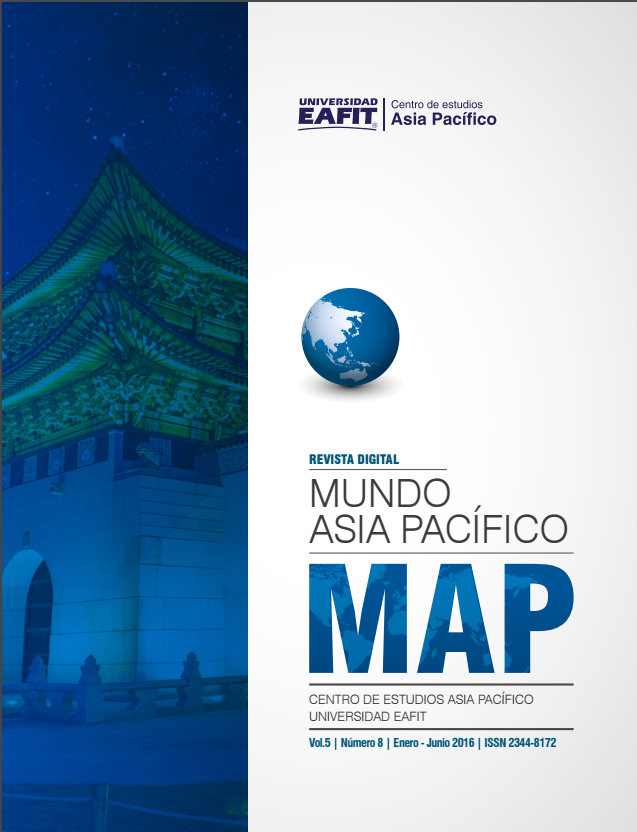Dinámicas de la población de la República de Corea a partir de 1960 y su relación con la transición demográfica
Main Article Content
Keywords
República de Corea, transición demográfica, crecimiento poblacional, envejecimiento, fecundidad, mortalidad
Resumen
El proceso de transición demográfica en la República de Corea, donde las altas tasas de mortalidad que se mantuvieron hasta los años posteriores a la Guerra disminuyeron significativamente, seguidas de la reducción de tasas de fecundidad, fue moldeando las dinámicas y la distribución de su población, la cual experimentó un proceso de expansión y posterior envejecimiento. El presente artículo describe los principales cambios en las dinámicas de la población coreana a partir de la década de 1960 (década en la que se comenzaron a implementar programas de planeación familiar a gran escala, como parte de las políticas de desarrollo económico de los planes quinquenales); identificando dos características principales de la transición demográfica: los cambios en la distribución de la población y el envejecimiento poblacional.
Descargas
Los datos de descargas todavía no están disponibles.
Referencias
Bloom, D. and J. G. Williamson (1997). Demographic transitions and economic miracles in emerging Asia. NBER Working Paper Series. N. B. o. E. Research, National Bureau of Economic Research. 6268
Casterline, J. (2003). Demographic transition. Encyclopedia of Population. P. Demeny and G. McNicoll, Macmillan.
Chun, H., L. Doyal, et al. (2006). “Understanding Women, Health, and Social Change: The Case of South Korea.” International Journal of Health Services
Dyson, T. (2001). “A partial theory of world development: The neglected role of the demographic transition in the shaping of modern society.” International Journal of Population Geography.
Heon , J. S. (2010). Kitakyushu Forum on Asian Women. Recuperado el 3 de Abril de 2016, de http://www.kfaw.or.jp/report/pdf/CSW%20Suh.pdf
Myrskyla, M., H.-P. Kohler, et al. (2009). “Advances in development reverse fertility declines.” Nature.
McGuire, J. W. (2001). “Social Policy and Mortality Decline in East Asia and Latin America.” World Development.
McNay, Kirsty. Women’s changing roles in the context of the demographic transition, Education for All Global. Monitoring Report 2003/4 Gender and Education for All: The Leap to Equality
Phang, H. S. (2003). Rapid Ageing and Labor Force Changes in Korea. International Seminar on Low Fertility and Rapid Ageing. Seoul, Republic of Korea, Korea Labor Institute .
Phang, H. S. (2003). Rapid Ageing and Labor Force Changes in Korea. International Seminar on Low Fertility and Rapid Ageing. Seoul, Republic of Korea, Korea Labor Institute .
Phang, H. S. (2005). Demographic Dividend and Labour Force Transformations in Asia: The Case of Korea. United Nations Expert Group Meeting on Social and Economic Implications of Changing Population Age Structures. Mexico City, Mexico, UN: Population Division. Department of Economic and Social Affairs. D. population ageing and future labour force (pp. 129).
OECD (1998). Korea. Reviews of national policies for education. Paris, France, Organisation for Economic Co-operation and Development.
OECD (2004). Ageing and Employment Policies: Korea. Ageing and Employment Policies Project. M. Keese and J. Lee, Organization for Economic Co-Operation and Economic Development.
Yang, J. M. (1977). Family planning program in Korea. 18. (Y. M. Journal, Ed.) Seúl,Korea. Obtenido de http://synapse.koreamed.org/Synapse/Data/PDFData/0069YMJ/ymj-18-64.pdf
Casterline, J. (2003). Demographic transition. Encyclopedia of Population. P. Demeny and G. McNicoll, Macmillan.
Chun, H., L. Doyal, et al. (2006). “Understanding Women, Health, and Social Change: The Case of South Korea.” International Journal of Health Services
Dyson, T. (2001). “A partial theory of world development: The neglected role of the demographic transition in the shaping of modern society.” International Journal of Population Geography.
Heon , J. S. (2010). Kitakyushu Forum on Asian Women. Recuperado el 3 de Abril de 2016, de http://www.kfaw.or.jp/report/pdf/CSW%20Suh.pdf
Myrskyla, M., H.-P. Kohler, et al. (2009). “Advances in development reverse fertility declines.” Nature.
McGuire, J. W. (2001). “Social Policy and Mortality Decline in East Asia and Latin America.” World Development.
McNay, Kirsty. Women’s changing roles in the context of the demographic transition, Education for All Global. Monitoring Report 2003/4 Gender and Education for All: The Leap to Equality
Phang, H. S. (2003). Rapid Ageing and Labor Force Changes in Korea. International Seminar on Low Fertility and Rapid Ageing. Seoul, Republic of Korea, Korea Labor Institute .
Phang, H. S. (2003). Rapid Ageing and Labor Force Changes in Korea. International Seminar on Low Fertility and Rapid Ageing. Seoul, Republic of Korea, Korea Labor Institute .
Phang, H. S. (2005). Demographic Dividend and Labour Force Transformations in Asia: The Case of Korea. United Nations Expert Group Meeting on Social and Economic Implications of Changing Population Age Structures. Mexico City, Mexico, UN: Population Division. Department of Economic and Social Affairs. D. population ageing and future labour force (pp. 129).
OECD (1998). Korea. Reviews of national policies for education. Paris, France, Organisation for Economic Co-operation and Development.
OECD (2004). Ageing and Employment Policies: Korea. Ageing and Employment Policies Project. M. Keese and J. Lee, Organization for Economic Co-Operation and Economic Development.
Yang, J. M. (1977). Family planning program in Korea. 18. (Y. M. Journal, Ed.) Seúl,Korea. Obtenido de http://synapse.koreamed.org/Synapse/Data/PDFData/0069YMJ/ymj-18-64.pdf

